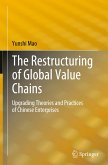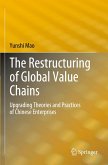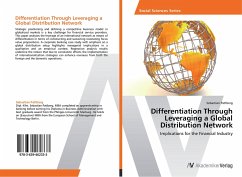Lizhi Xing
Complex Network-Based Global Value Chain Accounting System
From the Perspective of Econophysics
Lizhi Xing
Complex Network-Based Global Value Chain Accounting System
From the Perspective of Econophysics
- Broschiertes Buch
- Merkliste
- Auf die Merkliste
- Bewerten Bewerten
- Teilen
- Produkt teilen
- Produkterinnerung
- Produkterinnerung
This book aims to theoretically and empirically enrich the GVC accounting framework with statistical physics and complex network theory from the perspective of econophysics, thus adding up to the existing theories. Besides, it also aims at capturing the essences of network models such as topological complexity, hierarchy, transmissibility, interaction, and causality and reflecting the objective interrelations among economies or between economies and economic systems on the GVC, so as to reveal the inherent evolution of the cross-regional and even global economic systems.
Andere Kunden interessierten sich auch für
![Complex Network-Based Global Value Chain Accounting System Complex Network-Based Global Value Chain Accounting System]() Lizhi XingComplex Network-Based Global Value Chain Accounting System103,99 €
Lizhi XingComplex Network-Based Global Value Chain Accounting System103,99 €![The Restructuring of Global Value Chains The Restructuring of Global Value Chains]() Yunshi MaoThe Restructuring of Global Value Chains95,99 €
Yunshi MaoThe Restructuring of Global Value Chains95,99 €![The Restructuring of Global Value Chains The Restructuring of Global Value Chains]() Yunshi MaoThe Restructuring of Global Value Chains95,99 €
Yunshi MaoThe Restructuring of Global Value Chains95,99 €![Shaping Global Industrial Relations Shaping Global Industrial Relations]() Shaping Global Industrial Relations37,99 €
Shaping Global Industrial Relations37,99 €![Differentiation Through Leveraging a Global Distribution Network Differentiation Through Leveraging a Global Distribution Network]() Sebastian PattbergDifferentiation Through Leveraging a Global Distribution Network20,99 €
Sebastian PattbergDifferentiation Through Leveraging a Global Distribution Network20,99 €![Who profits from commoditizing Christmas: Development prospects for Georgia in the Nordmann fir global production network Who profits from commoditizing Christmas: Development prospects for Georgia in the Nordmann fir global production network]() Teona DarchiaWho profits from commoditizing Christmas: Development prospects for Georgia in the Nordmann fir global production network29,95 €
Teona DarchiaWho profits from commoditizing Christmas: Development prospects for Georgia in the Nordmann fir global production network29,95 €![Network Embeddedness Network Embeddedness]() Milena Ratajczak-MrozekNetwork Embeddedness110,99 €
Milena Ratajczak-MrozekNetwork Embeddedness110,99 €-
-
-
This book aims to theoretically and empirically enrich the GVC accounting framework with statistical physics and complex network theory from the perspective of econophysics, thus adding up to the existing theories. Besides, it also aims at capturing the essences of network models such as topological complexity, hierarchy, transmissibility, interaction, and causality and reflecting the objective interrelations among economies or between economies and economic systems on the GVC, so as to reveal the inherent evolution of the cross-regional and even global economic systems.
Produktdetails
- Produktdetails
- Verlag: Springer / Springer Nature Singapore / Springer, Berlin
- Artikelnr. des Verlages: 978-981-16-9266-6
- 1st ed. 2022
- Seitenzahl: 376
- Erscheinungstermin: 10. Februar 2023
- Englisch
- Abmessung: 235mm x 155mm x 21mm
- Gewicht: 569g
- ISBN-13: 9789811692666
- ISBN-10: 9811692661
- Artikelnr.: 67280721
- Verlag: Springer / Springer Nature Singapore / Springer, Berlin
- Artikelnr. des Verlages: 978-981-16-9266-6
- 1st ed. 2022
- Seitenzahl: 376
- Erscheinungstermin: 10. Februar 2023
- Englisch
- Abmessung: 235mm x 155mm x 21mm
- Gewicht: 569g
- ISBN-13: 9789811692666
- ISBN-10: 9811692661
- Artikelnr.: 67280721
Lizhi Xing, Ph. D. in management, is Associate Researcher in College of Economics and Management, Beijing University of Technology. His work adopts Inter-Country Input-Output (ICIO), also called Multi-Region Input-Output (MRIO), data to build weighted and directed complex network models, which are the basis of measurement, simulation, and prediction on the international trade.
Preface.- Part I Background.- Chapter 1 Fundamental Issues in This Book.- Part II Topological Structure.- Chapter 2 Recognize the Trade Roles of Industrial Sectors.- Chapter 3 Probe the Industrial Linkages Reasonably and Effectively.- Chapter 4 Find the Vital Industrial Sectors and IO Relations.- Part III Markov Process.- Chapter 5 Measure the Global Impact of Industrial Sectors.- Chapter 6 Measure the Impact of Final Demands on the Global Production System.- Chapter 7 Industrially Economic Impacts of Trump Administration's Trade Policy toward China.- Part IV Competition and Collaboration.- Chapter 8 Quantify the Competitive Strength and Weakness of Economies.- Chapter 9 Quantify the Collaborative Opportunity and Threat of Economies.- Part V Evolutionary Mechanism.- Chapter 10 Extract the Backbone of Global Value Chain.- Chapter 11 Identify the Worldwide Industrial Transfer Pattern.- Chapter 12 Depict the Nested Structure of Production System.- Part VI Causal Inference.- Chapter 13 Connect the Structural Features and Economic Status.- Postscript.- Appendix.- References
Preface.- Part I Background.- Chapter 1 Fundamental Issues in This Book.- Part II Topological Structure.- Chapter 2 Recognize the Trade Roles of Industrial Sectors.- Chapter 3 Probe the Industrial Linkages Reasonably and Effectively.- Chapter 4 Find the Vital Industrial Sectors and IO Relations.- Part III Markov Process.- Chapter 5 Measure the Global Impact of Industrial Sectors.- Chapter 6 Measure the Impact of Final Demands on the Global Production System.- Chapter 7 Industrially Economic Impacts of Trump Administration's Trade Policy toward China.- Part IV Competition and Collaboration.- Chapter 8 Quantify the Competitive Strength and Weakness of Economies.- Chapter 9 Quantify the Collaborative Opportunity and Threat of Economies .- Part V Evolutionary Mechanism.- Chapter 10 Extract the Backbone of Global Value Chain.- Chapter 11 Identify the Worldwide Industrial Transfer Pattern.- Chapter 12 Depict the Nested Structure of Production System.- Part VI Causal Inference.- Chapter 13 Connect the Structural Features and Economic Status.- Postscript.- Appendix.- References
Preface.- Part I Background.- Chapter 1 Fundamental Issues in This Book.- Part II Topological Structure.- Chapter 2 Recognize the Trade Roles of Industrial Sectors.- Chapter 3 Probe the Industrial Linkages Reasonably and Effectively.- Chapter 4 Find the Vital Industrial Sectors and IO Relations.- Part III Markov Process.- Chapter 5 Measure the Global Impact of Industrial Sectors.- Chapter 6 Measure the Impact of Final Demands on the Global Production System.- Chapter 7 Industrially Economic Impacts of Trump Administration's Trade Policy toward China.- Part IV Competition and Collaboration.- Chapter 8 Quantify the Competitive Strength and Weakness of Economies.- Chapter 9 Quantify the Collaborative Opportunity and Threat of Economies.- Part V Evolutionary Mechanism.- Chapter 10 Extract the Backbone of Global Value Chain.- Chapter 11 Identify the Worldwide Industrial Transfer Pattern.- Chapter 12 Depict the Nested Structure of Production System.- Part VI Causal Inference.- Chapter 13 Connect the Structural Features and Economic Status.- Postscript.- Appendix.- References
Preface.- Part I Background.- Chapter 1 Fundamental Issues in This Book.- Part II Topological Structure.- Chapter 2 Recognize the Trade Roles of Industrial Sectors.- Chapter 3 Probe the Industrial Linkages Reasonably and Effectively.- Chapter 4 Find the Vital Industrial Sectors and IO Relations.- Part III Markov Process.- Chapter 5 Measure the Global Impact of Industrial Sectors.- Chapter 6 Measure the Impact of Final Demands on the Global Production System.- Chapter 7 Industrially Economic Impacts of Trump Administration's Trade Policy toward China.- Part IV Competition and Collaboration.- Chapter 8 Quantify the Competitive Strength and Weakness of Economies.- Chapter 9 Quantify the Collaborative Opportunity and Threat of Economies .- Part V Evolutionary Mechanism.- Chapter 10 Extract the Backbone of Global Value Chain.- Chapter 11 Identify the Worldwide Industrial Transfer Pattern.- Chapter 12 Depict the Nested Structure of Production System.- Part VI Causal Inference.- Chapter 13 Connect the Structural Features and Economic Status.- Postscript.- Appendix.- References







